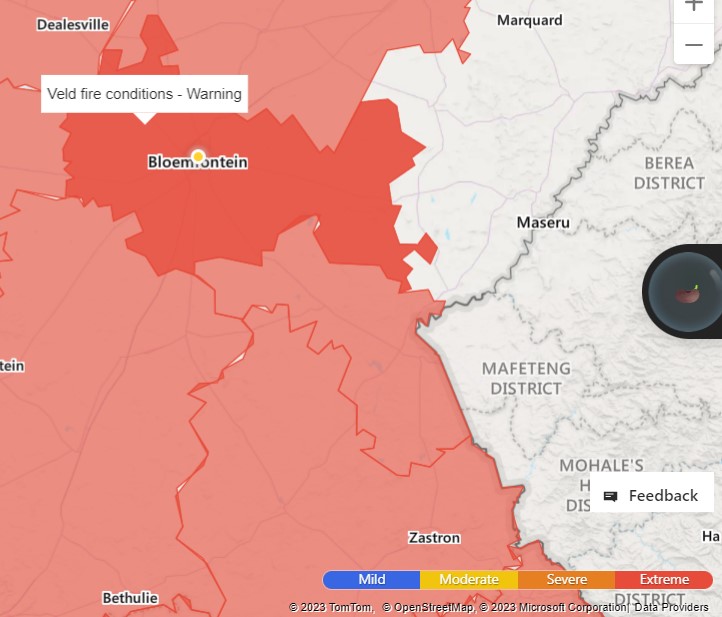Landowners and the public should take heed of
fire danger ratings as this may help anticipate potential veld fires (wildfires).
Free State vegetationThe Free State Province is well-known for many things, one of which is that it consists of major highveld grasslands with various land-use practices. What is also well-known is that we have entered a season where our grasslands are at its most vulnerable – our grasslands are at its driest, temperatures are warming up and wind conditions are not the most favourable. This often means weather conditions that are ripe for veld fires and/or conditions that make veld fires highly probable. This is the season; In the last two weeks, the
Free State Disaster Management have also been on high alert over possible veld fires and/or the weather conditions that have added to this.
Because the season now calls for it, it is important to discuss what can be done to assist with averting and mitigating the possibility of an increase in veld fires. They say education goes a long way and that is the very answer, educating landowners and the public at large about the awareness of the fire danger ratings and/or the fire danger index (fdi). Landowners and the public at large can assist with averting and mitigating the occurrence of veld fires by simply knowing their fire danger ratings.
Fire danger rating
But what is a fire danger rating? The
fire danger rating system is used to provide a measure of the relative seriousness of burning conditions and the threat of fire by providing an accurate measure as possible of the relative seriousness of burning conditions. The system processes and evaluates factors influencing fire danger and systematically represents them in the form of fire indices. Fire danger rating emanates from Chapter 3 - Section 9(1) of the National Veld and Forest Fire Act 101 of 1998 (The Act). Chapter 3 of the Act provides for the prevention of veldfires through a fire danger rating system. Section 9(1) of the Act provides that the Minister of Agriculture, Forestry and Fisheries, must prepare and maintain on a continuous basis a fire danger rating system for the entire country in consultation with the
South African Weather Bureau or any successor to that Bureau; and Fire Protection Associations.
The
Department of Agriculture, Forestry and Fisheries’ fire danger rating system for general information in terms of Section 9(1) of the Act was gazetted in General Notice 1099 of 2013. This publication provides an exposition of the fire danger rating and it provides for the official colours of the fire danger rating model. The
fire danger rating model has
five official colours.
Namely:
Blue,
Green,
Yellow,
Orange and
Red. These colours specifically rate the level and categories of the likelihood of fires occurring in a given area.
Interpreting the colours
How can these colours be interpreted? The colours in the fire danger rating model each have a specific meaning. The meaning associated with each colour can be described as follows:
blue means that the fire danger index is
low and the rating is insignificant,
green means that the fire danger index is
moderate and the rating is low,
yellow means that the fire danger index is
dangerous and the rating is medium,
orange means that the fire danger index is
very dangerous and the rating is high, and,
red means that the fire danger index is
extremely dangerous and the rating is extremely high.
 Image above: Example of the fire danger ratings as on 08 September 2023.
Image above: Example of the fire danger ratings as on 08 September 2023.
Source: https://www.msn.com/en-za/weather/maps/severeweatherIt is important that awareness is created in relation to the fire danger rating because these ratings not only assist with anticipating the occurrence of fires but also indicate how dangerous a fire could be at a given moment. These ratings are particularly important because they assist with determining the measures that need to be taken for protective and preventative measures.
Stay informed, stay safe. Consult with our expert,
Eldon Ward, for comprehensive insights and legal support regarding veld fire cases. Together, we can protect our communities and precious landscapes from the devastating impact of wildfires.
Look out for our next article on a breakdown of
what to do and what not to do in each danger rating category.
Disclaimer: This article is the personal opinion/view of the author(s) and is not necessarily that of the firm. The content is provided for information only and should not be seen as an exact or complete exposition of the law. Accordingly, no reliance should be placed on the content for any reason whatsoever and no action should be taken on the basis thereof unless its application and accuracy have been confirmed by a legal advisor. The firm and author(s) cannot be held liable for any prejudice or damage resulting from action taken based on this content without further written confirmation by the author(s).